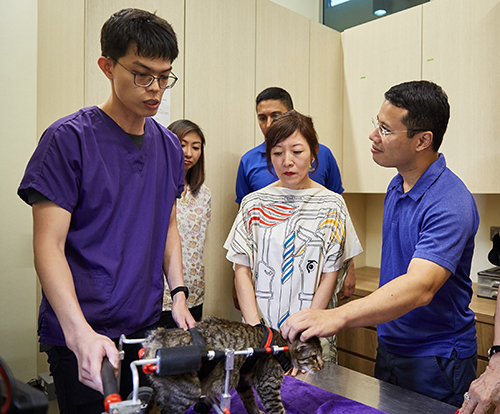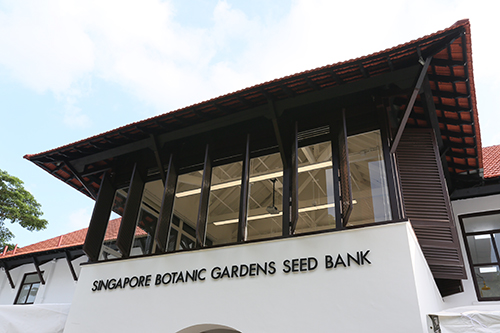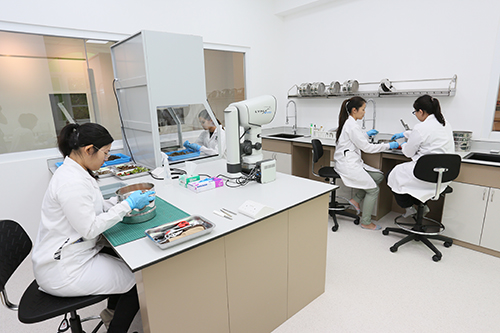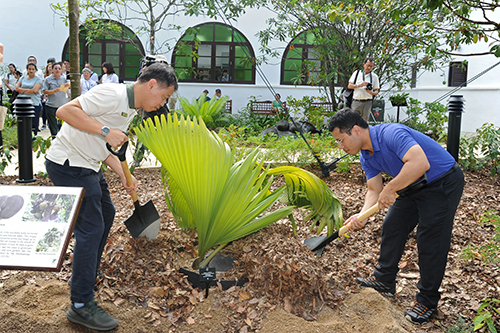July saw the launch of two avenues to greatly benefit animals and plants. One improves the health and welfare of our community animals, and the other strengthens conservation efforts for plant biodiversity.
Giving better care to community animals
On 6 July 2019, Minister for Social and Family Development and Second Minister for National Development Mr Desmond Lee officiated at the opening of the Society for the Prevention of Cruelty to Animals (SPCA)’s upgraded Community Animal Clinic.
SPCA is one of the animal welfare groups (AWGs) that the Animal & Veterinary Service (AVS), a cluster of the National Parks Board (NParks), works closely with. SPCA’s clinic has provided prompt medical care and rehabilitation for many community animals, who are often found in poor health.
Now equipped with more advanced diagnostic capabilities, the upgraded clinic will be able to provide more advanced treatment for injured or sick community animals. It will also play a bigger role in supporting the Trap-Neuter-Release-Manage (TNRM) programme for stray dogs.

Launched in November 2018, the five-year TNRM programme for stray dogs is a collaboration between NParks, AWGs, the Singapore Veterinary Association, and the community. This nationwide programme is a humane, science-based approach to managing Singapore’s stray dog population.
Under the programme, NParks provides funding support to the AWGs conducting pre- and post-surgical boarding, sterilisation, vaccination and microchipping for dogs. Several AVS veterinarians also help to carry out basic body examinations, sterilisation procedures, and post-operative care at SPCA’s clinic.
With the upgraded clinic, SPCA can now handle about 20 per cent more TNRM sterilisation surgeries, and it expects to further increase this capacity by end-2019. At the same time, NParks is working with the partner AWGs and various stakeholders on other TNRM efforts, including outreach initiatives.
Saving seeds for the present and future
On 13 July 2019, NParks opened Singapore’s first seed bank at the Singapore Botanic Gardens. Located in the conserved House 4 at Cluny Road, the Seed Bank can store the seeds of up to 25,000 plant species, approximately half the total number of plant species in the region and more than double the current 10,000 plant species in the Singapore Botanic Gardens’ living collection.
This will help safeguard the germplasm of threatened plant species in Southeast Asia, and will support vital research into optimising storage methods for these seeds.

Collecting seeds for storage helps build a valuable resource for habitat restoration and species conservation. The Seed Bank will strengthen the Gardens’ capacity to insure native plant populations against threats such as disease, climate change, and natural and man-made disasters.
Besides collecting seeds from Singapore’s forests, nature areas, and parks, the Gardens will also collaborate with other botanic gardens and research institutions on seed exchanges.
Research is crucial to continually optimise seed storage procedures and to understand the physiology of different seeds.

The Seed Bank strengthens the Gardens’ universal value as a UNESCO World Heritage Site, providing opportunities for visitors to learn about seeds and the science of seed storage through its interpretive gallery and outdoor garden. The interpretive gallery features informative and interactive displays, such as seed specimens and glass windows with explanatory captions providing a glimpse into the various laboratories and rooms. Meanwhile, the outdoor garden with seed sculptures behind the Seed Bank offers a more intimate experience for visitors to learn about seed dispersal.

The Gardens’ efforts in conservation, research and education would not be possible without support from the community through NParks’ registered charity and IPC, the Garden City Fund. This includes a generous donation of $1 million from the Goh Foundation in memory of Mrs Goh Cheng Liang née Teo Sok Yong. Other donors include HSBC, Goldbell Foundation, Yokogawa Engineering Asia Pte Ltd, Alfa Tech, Kirtida & Bharat Mekani, Britesparx Design Pte Ltd, and Benel Singapore.
In total, more than $1.17 million has been raised to help initiate the research and education elements at the Seed Bank. NParks aims to raise a further $5 million over the next 10 years through the Garden City Fund’s Give to the Gardens programme for conservation, research, and education efforts at the Seed Bank.
You can contribute to these efforts by donating through the Give to the Gardens programme. And if you’re curious to find out more about seed banking and seed biology, visit the Singapore Botanic Gardens Seed Bank, open daily from 9 am to 6 pm except for the last Friday of every month.







